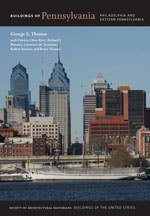
Until the start of World War I, Bethlehem's residential districts grew only gradually to the north and east of the Moravian core. But the war increased Bethlehem Steel's workforce from 11,000 in 1914 to 28,000 in 1917, which brought about two large-scale housing developments: Elmwood Park and Pembroke Village ( NO32). Elmwood Park was financed privately by Pittsburgh developers Wood and Hawthorne. A thirteen-acre site was laid out on an oval street pattern enclosing a central playground on the English Garden City model. The houses were advertised as “the most exclusive New York and Long Island types of artistic homes,” which in practice meant a common one-and-one-half- or two-story scale and Colonial Revival details. At the same time, the housing alternated picturesquely between single residences, doubles, triples, and apartments. Some triples show the “butterfly” plan beloved by Arts and Crafts architects. A total of 235 lots were laid out though only 158 houses had been built and sold by 1920.














